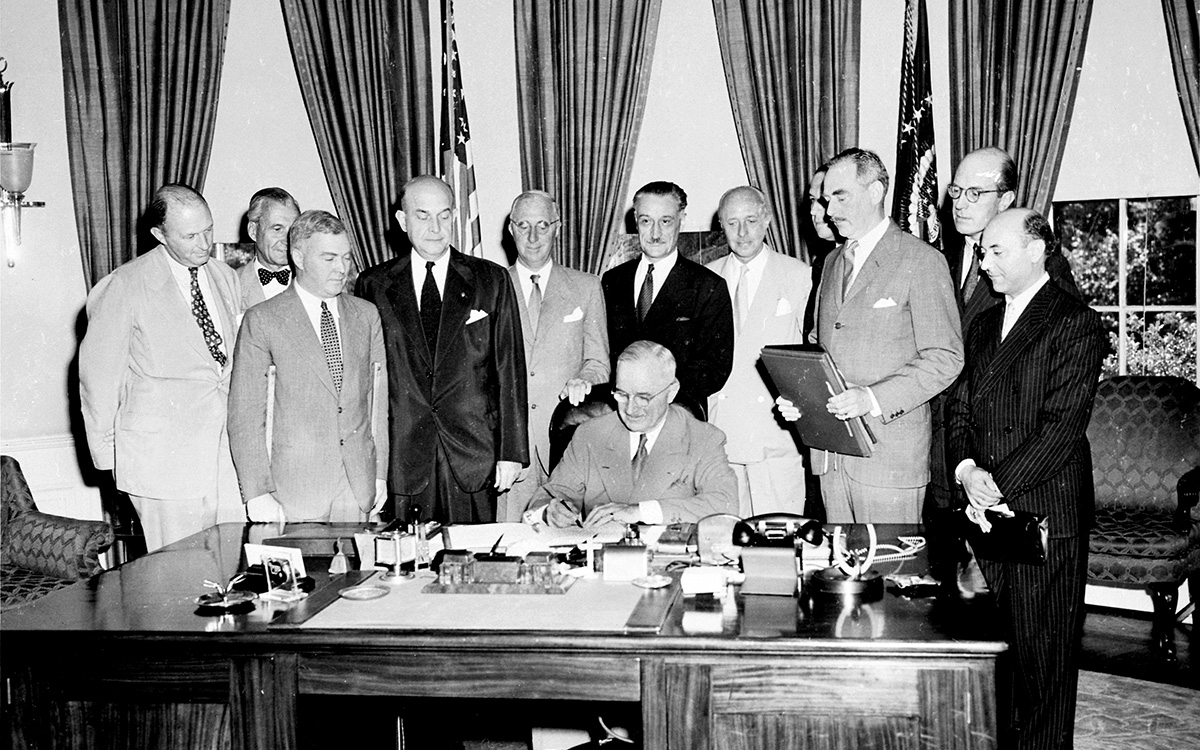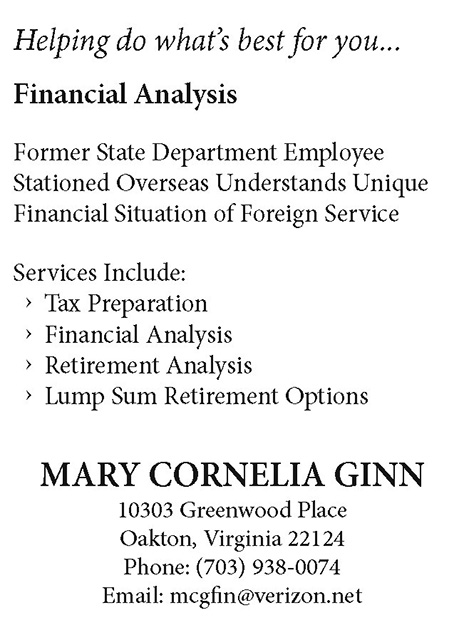Global Shifts and American Political Will as NATO Turns 70
In a difficult moment, NATO’s historical success, together with current operational advances, will once again see the alliance through.
BY STEVEN KEIL

President Harry S Truman signs the Washington Treaty forming NATO on April 4, 1949, in Washington, D.C. Secretary of State Dean Acheson stands to his left with the document folder.
Abbie Rowe / National Archives and Records Administration
On April 4 partners on both sides of the Atlantic will mark 70 years since the signing of the Washington Treaty and the founding of the NATO Alliance. What should be a momentous occasion to celebrate the stability and peace accompanying one of the most successful alliances in history will be clouded by a difficult political reality, one that has complicated cohesion across the trans-Atlantic space.
For those who have studied the alliance’s history, much of today’s discussion will be familiar. It is a well-worn song whose current verses have been stuck in the heads of experts and officials alike since the end of the Cold War. From NATO’s strategic purpose to its capabilities gap, anyone remotely acquainted can hum along. But several discontents have grown sharper as the years have moved on. Today, discussions on burden-sharing and the role of the United States are particularly shrill.
At the strategic level, U.S. policy toward NATO will be one of the most defining factors for allies in the coming years, and it also poses some of the most serious questions. Will U.S. policymakers’ patience with anemic European defense spending run out? How much longer will European governments suffer the tone of Washington’s current rhetoric? Will U.S. disenchantment with multilateralism increase? These are just a few of the seriously challenging unknowns.
At the same time, there is an acute sense of growing geopolitical threats facing the United States and an accompanying irony in high-level U.S. rhetoric toward NATO. The importance of alliances has only grown as challenges and competitors proliferate in the increasingly multipolar international environment.
Current discontents do not indicate that NATO is on a path to imminent irrelevance; but they do demonstrate that strategic consensus will likely need to be temporarily offset by wins at the functional and tactical level. Sustaining momentum and stewarding operational-level victories will be a critical task for diplomats, officials and experts engaging in alliance politics today.
Old Storms and New Ones
For many watching U.S.-NATO politics as the 70th anniversary nears, there is clearly a sense of alarm. But history reveals that this is not the first difficult moment facing the alliance. Many NATO-watchers would cite the Suez Crisis or, more recently, the second Iraq War as moments of significant political turmoil. But as renowned historian Sir Michael Howard argued in his 1999 Foreign Affairs article evaluating the NATO alliance at 50, the two periods of most serious concern were those surrounding the Cuban Missile Crisis (1958-1963) and the Euromissile Crisis (1979-1984).
In both instances, the United States questioned the legitimacy of its own deterrent capability, and this fueled existential doubts across the alliance. As it happened, both situations were alleviated by strong U.S. leadership that held the Soviets in check and revived allied trust and confidence, allowing both the United States and the alliance to emerge stronger.
These examples are instructive because they demonstrate that strategic challenges facing U.S. NATO policy can be weathered in extremely difficult and strategically daunting circumstances. Moreover, the situation can be corrected by decisive U.S. leadership and determination in the interest of the allies.
These examples are also illuminating because they point to what is different in NATO politics today. The fundamental challenge facing U.S. NATO policy is no longer necessarily one of self-confidence, but of political will. This can be more problematic for the alliance because it suggests that U.S. policy could trend toward willful strategic estrangement. Moreover, it could happen even though that option is incongruous with the demands of the current global context.
Although today’s strategic reality does not feature a unified collective angst directed at one strategic priority, as was the case during the Cold War, it is not without significant challenges. In fact, it presents a complicated picture of new risks across regions in an era of shifting geopolitics. Gone are the days when many assumed that a new, cooperative and ever-expanding multilateral, democratic world that enhanced the security of all those willing to play by its rules was imminent. Instead, China’s expanding geo-economic influence through Central Asia, Africa and now much of Europe signals an increased ambition to reset the rules of the road. Simultaneously, Russia is directly challenging a spectrum of post–Cold War assumptions, both in the post-Soviet space as well as in places like the Middle East. Adding to this, many within Europe and the alliance itself are calling into question some of the value-laden foundational elements of the Washington Treaty, leading to decision-making that departs from unified alliance interests (e.g., Turkey’s decision to purchase Russia’s S-400 missile defense system despite protest from allies).
For the United States, the growing multipolarity directly challenges the preponderance of U.S. capability and influence across the globe, and Washington’s ability to effectively tackle a wide range of threats. Official U.S. policy documents over recent years recognize this reality. The most recent National Security Strategy claimed that: “The United States will respond to the growing political, economic and military competitions we face around the world. China and Russia challenge American power, influence and interests, attempting to erode American security and prosperity.” And speaking to U.S. military capabilities, the document goes on to say: “U.S. advantages are shrinking as rival states modernize and build up their conventional and nuclear forces.”
While divisions exist, the alliance provides an essential platform for deliberation and debate on how to confront the many challenges facing the various NATO allies.
The document also points to unconventional threats challenging U.S. security policy that span domains and confuse traditional responses. A quick look at current trends show that much of today’s geopolitical competition is happening at a subconventional level. Political warfare fought through economic coercion, cyber activity and propaganda is penetrating societies in Europe and the United States. To counter these threats, a robust and collective response is required.
As the United States and NATO face the most difficult geopolitical environment of the last 30 years, the alliance is staring down a significant and self-inflicted question of legitimacy. Specifically, for U.S. policy toward NATO, the key factor undermining fundamental confidence in the alliance is a question of whether the United States should continue to engage in the same fashion, not whether it is able to.
An added layer to this irony is the fact that this is occurring at a time when U.S. policy so acutely needs dependable, capable and strong allies to confront the variety of geopolitical threats facing the United States in a rising multipolarity. NATO is a venue for political engagement, as well as a defensive alliance. It can foster resilience within and across societies, and respond to new and asymmetric threats. As the organization enters its eighth decade, a strong dose of realism for NATO members—including the United States—would go a long way in helping realize the critical role the alliance will play in meeting today’s challenges. For example, allies have agreed to set up counter-hybrid support teams that will assist and advise member-states in responding to various hybrid attacks. This includes cyberattacks, disinformation and economic pressure, among others. Moreover, NATO has taken large steps to bolster alliance credibility in unconventional domains like cyberspace. In August last year, the alliance launched a Cyber Operations Center.
Beyond this, NATO continues to be a conventional force multiplier. NATO joined the global coalition to defeat ISIS, supporting the coalition’s information sharing capability and airspace management. NATO also started a training and capacity-building mission in Iraq to help counter terrorism in the region and bolster Iraqi forces. To counter Russian aggression in Eastern Europe, several NATO members stepped up to the plate with NATO’s Enhanced Forward Presence, deploying a multinational deterrent presence in the Baltic states and Poland. Moreover, many nations began increasing defense spending in response to Russia’s blatant military aggressions against Ukraine in and since 2014.
Finally, NATO’s political advantages should not be dismissed. While divisions exist, the alliance provides an essential platform for deliberation and debate on how to confront the many challenges facing the various NATO allies across regions and domains. And because of its key role, NATO also provides a prominent space for American leadership in the world. Recent U.S. action on the Intermediate-Range Nuclear Forces Treaty, and the support of NATO allies for the U.S. withdrawal notice, is indicative of this. When the decision was hastily announced, it was met with widespread outcry. However, after deliberation and diplomacy within the alliance, the United States was able to articulate a position that was supported by allies, which gave added weight to the U.S. position.
It’s Not Just about U.S. Policy
The relevance of the alliance for the United States is clear. But it would be misguided to solely focus on this aspect of NATO politics and fail to address the real deficiencies within the alliance as it exists today. Certainly, capabilities gaps and burden-sharing challenges have contributed to the frustration of U.S. political will. As the geopolitical context has changed, impatience with these long-standing challenges has only further soured the American appetite.
Without question, defense spending remains at the top of the “to do” list for European counterparts in NATO. The United States benefits from its leadership role in the alliance, but the balance of current spending levels is not sustainable. And in the absence of a serious and sustained attempt to address meager European budgets, U.S. foreign policy officials and experts will continue to question whether the United States is getting a fair shake. It is in the interest of all NATO member-states to remove this talking point from alliance discussions, or at least greatly reduce it. Many NATO member-states, to their credit, began responding to an increasingly volatile security environment as early as 2014 by reversing course on the years of dwindling defense budgets.
However, European efforts should not just aim to address defense spending levels. NATO member countries must look at continued capability gaps and interoperability issues, as well. During the 2011 Libya mission some interoperability successes were a signal of confidence, but information-sharing hurdles and capability limitations facing key European allies were not. Increased investment over the past few years, as well as the new commands established after the last summit, should help. However, improvement in these areas must remain a priority. Moreover, NATO states that are also members of the E.U. must be sure they are not creating redundancies in similar E.U. initiatives, while leveraging those capabilities where possible (particularly in the realm of hybrid threats).
Finally, European NATO nations must move past the divide between eastern and southern member-states on threat perception, which leads to a false choice between either deterring Russia or fighting terrorism. NATO is a defensive alliance. Protecting territory and providing deterrence against would-be aggressors is the mission. Nevertheless, the alliance must be able to address regional threats, threats that could destabilize and adversely impact member-states. NATO shouldn’t have a knee-jerk reaction to act “out of area,” but it also shouldn’t believe it is insulated from instability in its southern neighborhood. Today the alliance is trying to tackle threats in both theaters, even if there is a lack of political consensus among member-states. However, to continue to properly confront these challenges, increased defense spending, capabilities development and interoperability across the alliance will be essential.
Conclusion
As NATO ministers mark the signing of the Washington Treaty this spring, there will be much focus on political divisions and uncertainties. But there is much to celebrate, too. The last 70 years witnessed an unprecedented era of peace despite the tensions of the Cold War and the uncertainties of the post–Cold War era. Conflict in Central and Western Europe today may not be impossible, but it certainly stretches the imagination. This is in large part due to the security guarantee by NATO, underwritten by American leadership, which afforded Europe a chance to seek a sustainable peace that has spanned several decades.
But it is not a foregone conclusion that what the alliance has been able to achieve in the past will continue into the future. Thankfully, as former Defense Secretary James Mattis said in an address last October: “In an unpredictable world, allies have renewed their sense of urgency.” NATO is as important today as it has ever been in the post–Cold War world. But as high-level rhetoric from the United States clashes with a clear need for strong, capable alliances, the efforts of officials and experts at the working level of the trans-Atlantic relationship will be critical. Understanding the key role that NATO can play in addressing the many challenges to U.S. security today, the alliance can overcome the tumult it is currently experiencing, as it has in the past.
In the meantime, it will be critical for NATO nations to remember that in confronting today’s challenges, no member is better off without the alliance. As NATO enters its eighth decade, a strong sense of the global challenges facing both sides of the Atlantic is crucial. And those who wish to see the stability of the last several decades extend into the future would do well to articulate this to their capitals and to their alliance counterparts.






